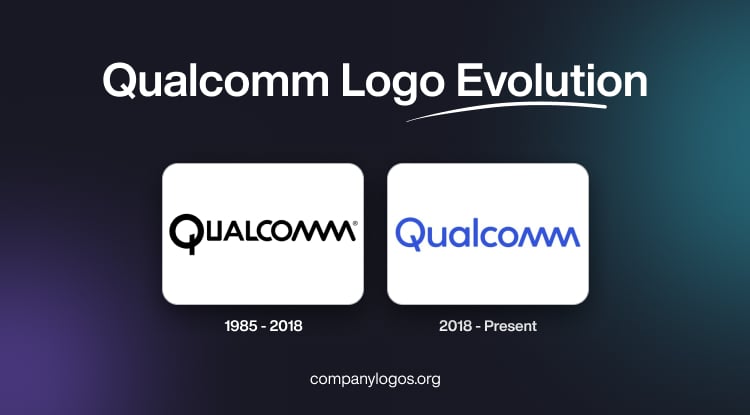
Qualcomm is a world-renowned US-based technology company known for revolutionising the world of wireless communication. It owns the 4G and 5G formats and is a leader in wireless chip technology. Established in 1985 by engineers Irwin Jacobs and Andrew Viterbi, the company can be said to be the veritable brain that drives most mobile devices of today.
The Qualcomm logo design conveys a sense of balance between creativity and engineering excellence. In fact, the history of the Qualcomm logo reflects the company’s evolution from its 1980s origins as a pioneering wireless technology firm to its position as a symbol of modern connectivity and innovation. The article delves into the evolution of the Qualcomm logo, among other details.
The Genesis of the Qualcomm Logo (1985 – 2018)
The original Qualcomm logo in monochrome colour featured the brand name in uppercase and in a custom geometric sans-serif typeface. The first letter, “Q,” was larger than the other letters, and the last two letters, “MM,” were depicted as a wave with rounded ends. The letter “Q” symbolises the power button on computers and other devices. The colour palette in white and black symbolises prestige, high status, and professionalism.

(2018 – Present)
The 2018 logo iteration was made more stylish and modern in collaboration with Interbrand. The colour black is replaced by vibrant blue to symbolise trust, dependability, and communication. The first letter, “Q,” has been changed to become more open and softer with rounded edges. The other glyphs have also been modified to match the wave-like letters “MM” at the end.

The Elements of the Qualcomm Logo
Font
The Qualcomm logo uses a modern sans-serif typeface to convey the characteristics of the field of telecommunications and wireless technologies. The letters display soft and smooth lines, and the presence of small spaces offers better readability.
Colour
The colour palette of the logo comprised light blue and white. Here, light blue is meant to convey reliability, trust, and responsibility, while the white background reflects honesty and integrity.
The History of Qualcomm
Qualcomm was founded in 1985 in San Diego, California, by Irwin Jacobs and six colleagues from the digital communications company Linkabit. The name “Qualcomm” is short for “QUALity COMMunications,” and it reflects the company’s mission to deliver breakthrough wireless communications technologies. In its early years, Qualcomm operated as a contract research and development facility. It focused on government and defence communication projects.
By 1988, it merged with Omninet to create Omnitracs, which was a successful satellite communications system for the trucking industry. It provided crucial revenue to fund Qualcomm’s research into Code Division Multiple Access (CDMA), an innovative wireless technology. Throughout the late 1980s and early 1990s, Qualcomm developed and commercialised CDMA technology, which allowed multiple users to share the same frequency spectrum using coded signals. This greatly improved efficiency compared to earlier standards like TDMA.
The first commercial CDMA network launched in 1993 established Qualcomm as an industry leader. The company went public in 1991, which enabled rapid expansion and investment in CDMA-based phones and infrastructure. By the mid-1990s, Qualcomm experienced significant growth, with revenues reaching $383 million in 1995 and $814 million in 1996. In 1999, Qualcomm strategically sold its manufacturing businesses, that is, base stations to Ericsson and handsets to Kyocera. Instead, it started focusing on patents and semiconductor design.
Entering the 2000s, Qualcomm concentrated on licensing CDMA and later 3G and 4G technologies. It supplied chips and intellectual property to much of the mobile device industry. It also introduced the first single-chip mobile solution in 1999, which led to the reduction in phone size and cost, a significant factor leading to worldwide mobile adoption. The launch of Snapdragon processors in 2011 became a major milestone, for they powered many of the world’s smartphones and drove exceptional growth.
Qualcomm also broadened its expertise through strategic acquisitions like Flarion, which specialised in OFDMA technology, and SnapTrack, known for A-GPS technology. While maintaining its global headquarters in San Diego, Qualcomm expanded internationally and generated much of its revenue from markets outside the United States by the early 2000s.
In more recent years, Qualcomm faced several challenges, including legal disputes over licensing practices and competition from rival chipmakers, but it sustained its leadership through continuous innovation and adaptation. The company diversified into automotive technologies such as autonomous driving and advanced driver-assistance systems (ADAS), as well as the Internet of Things (IoT) market.
In 2018, Qualcomm successfully withstood a hostile takeover bid by Broadcom, which was blocked by the U.S. government citing national security concerns. This allowed Qualcomm to remain independent and continue its emphasis on advancing 5G technologies. Today, Qualcomm remains a critical player in leading the development and deployment of 5G wireless standards. It supplies chips and technology to next-generation networks and devices worldwide.
Qualcomm’s pioneering role in CDMA and its ongoing leadership through the evolution of 3G, 4G, and 5G networks, when combined with its strategic shift from manufacturing to intellectual property and semiconductor design, have cemented its status as one of the most influential companies in the wireless communications industry. The company’s history is a testament to visionary engineering, technological innovation, and strategic adaptation, which led to the shaping of the modern wireless world for over four decades.
Interesting Facts About Qualcomm
- Qualcomm developed Code Division Multiple Access (CDMA) technology, which revolutionised wireless communications in the 1990s. CDMA allowed multiple calls to be transmitted over the same frequency, which vastly improved network efficiency and quality.
- Qualcomm developed the Snapdragon system-on-chip (SoC) series, which is used widely in Android smartphones. These chips power phones from brands like Samsung, OnePlus, Xiaomi, and others. These handle everything from CPU and GPU performance to AI processing and 5G connectivity.
- Qualcomm is a global leader in 5G technology. It played a crucial role in developing the standards and chipsets used in modern 5G devices, thereby helping usher in the next generation of wireless connectivity.
- The name Qualcomm is short for “Quality Communications.” The company was founded with the vision of improving wireless communication technology.
- Qualcomm was founded in 1985 in San Diego, California, by a group of engineers led by Irwin Jacobs and Andrew Viterbi (co-inventor of the Viterbi algorithm). The company started small but rapidly grew due to its breakthrough technologies.
- While many know Qualcomm for its chips, a significant portion of its revenue comes from licensing its wireless patents. Most smartphone makers pay Qualcomm to use its patented mobile technologies.
- Before becoming a mobile chip giant, Qualcomm made OmniTRACS, which is a satellite-based tracking system for commercial trucking. It was one of the earliest successful GPS-based fleet management solutions.
- In 2013, Qualcomm briefly entered the smartphone market with the Qualcomm Toq smartwatch and Snapdragon-branded reference phones. However, these ventures didn’t last long, and the company reaffirmed its focus on chipsets and R&D.
- Qualcomm was involved in a major legal battle with Apple, which accused it of anti-competitive practices. The dispute was settled in 2019, with Apple agreeing to a multi-year chipset supply and licensing agreement.
- Co-founder Andrew Viterbi was a professor at UCLA and later at UC San Diego. Qualcomm has deep roots in research and academia and continues to fund STEM initiatives, scholarships, and university partnerships.
- Qualcomm is expanding into automotive chips for connected cars and Internet of Things (IoT) devices. It offers platforms for digital cockpits, autonomous driving, and edge computing.
- Qualcomm has committed to reducing its environmental footprint. It aims to achieve net-zero greenhouse gas emissions by 2040. It is designing energy-efficient chips to reduce power consumption in mobile devices.
Finally
The Qualcomm logo, from its plain wordmark origins to its present dynamic swirling ‘Q,’ is more than just a visual signature. It stands as a beacon of technological progress, connectivity, and the relentless spirit of innovation that has defined the company for over four decades.